If you’ve been looking for the perfect French Macaron cookie recipe, you’ve come to the right place. I’ve assembled all the tips and tricks you’ll need in this ultimate guide walking you through how to make macarons!
For more step by step guides, be sure to take a peek at our How to Make Hot Cocoa Bombs! Everything you need for success in one place. And of course, my favorite Rice Krispie Treat guide with unique flavors and tips is a reader hit!
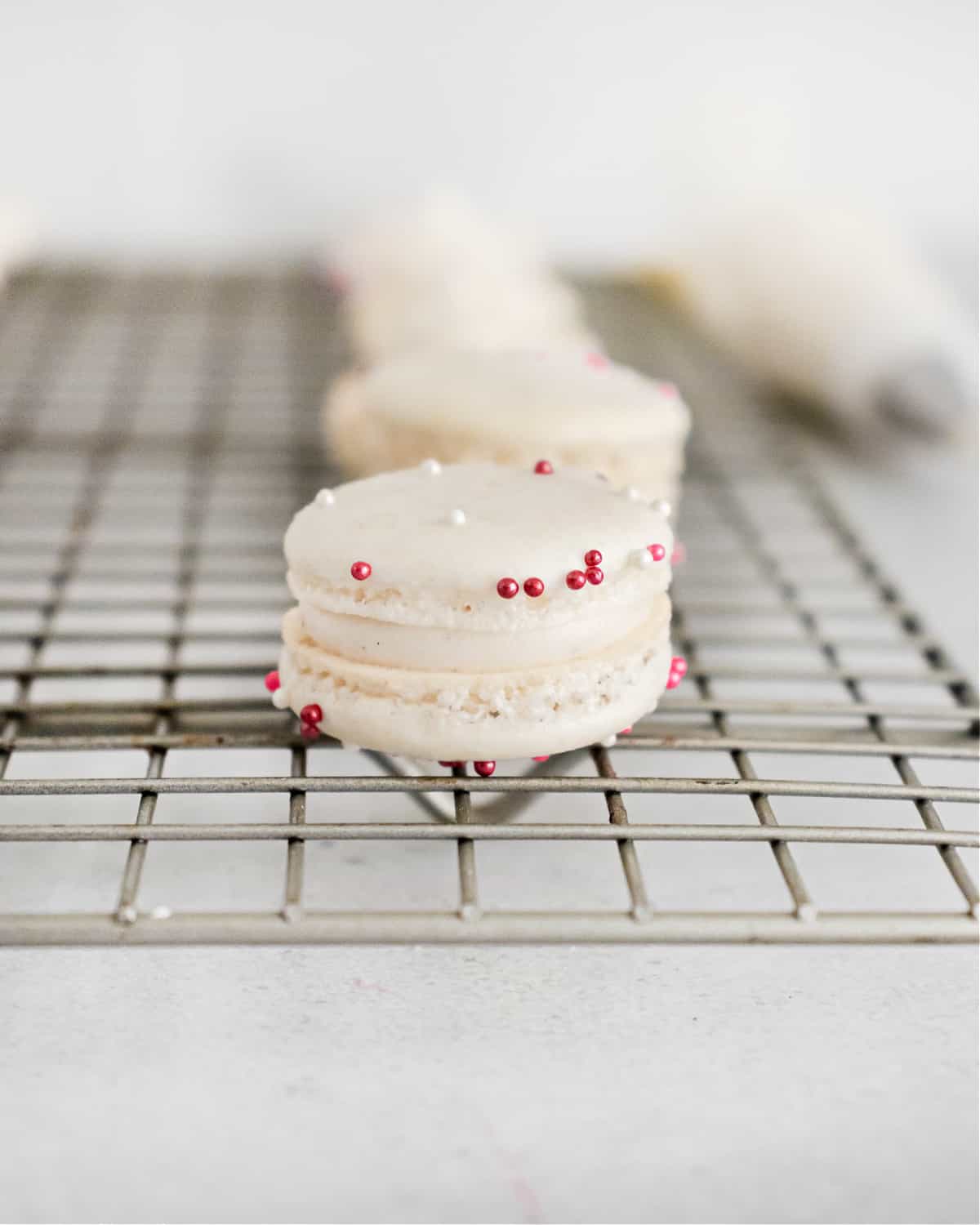
What are Macarons
If you’ve ever tasted a delicate macaron cookie, you know that feeling of indulgence.
But if you’ve attempted making macarons in the past, you also know they can be finicky. I’ve assembled all the step by step details YOU need to know to have perfect results EVERY single time you make macarons.
But first, let’s be clear. Macarons and Macaroons are too very different cookies.
- Macarons are a meringue based cookie traditionally filled with a sweet buttercream. One bite can immediately transport you to Paris, so I’ve been told.
- Macaroons are cookies made primarily from shredded coconut and egg to create a delicious soft cookie “mound.” Sometimes dipped in chocolate (which is amazing).
Once you’ve learned how to make a basic macaron (these vanilla bean macarons are simply the best), you can start mixing up your flavors and trying new ingredients!
Ready to start?
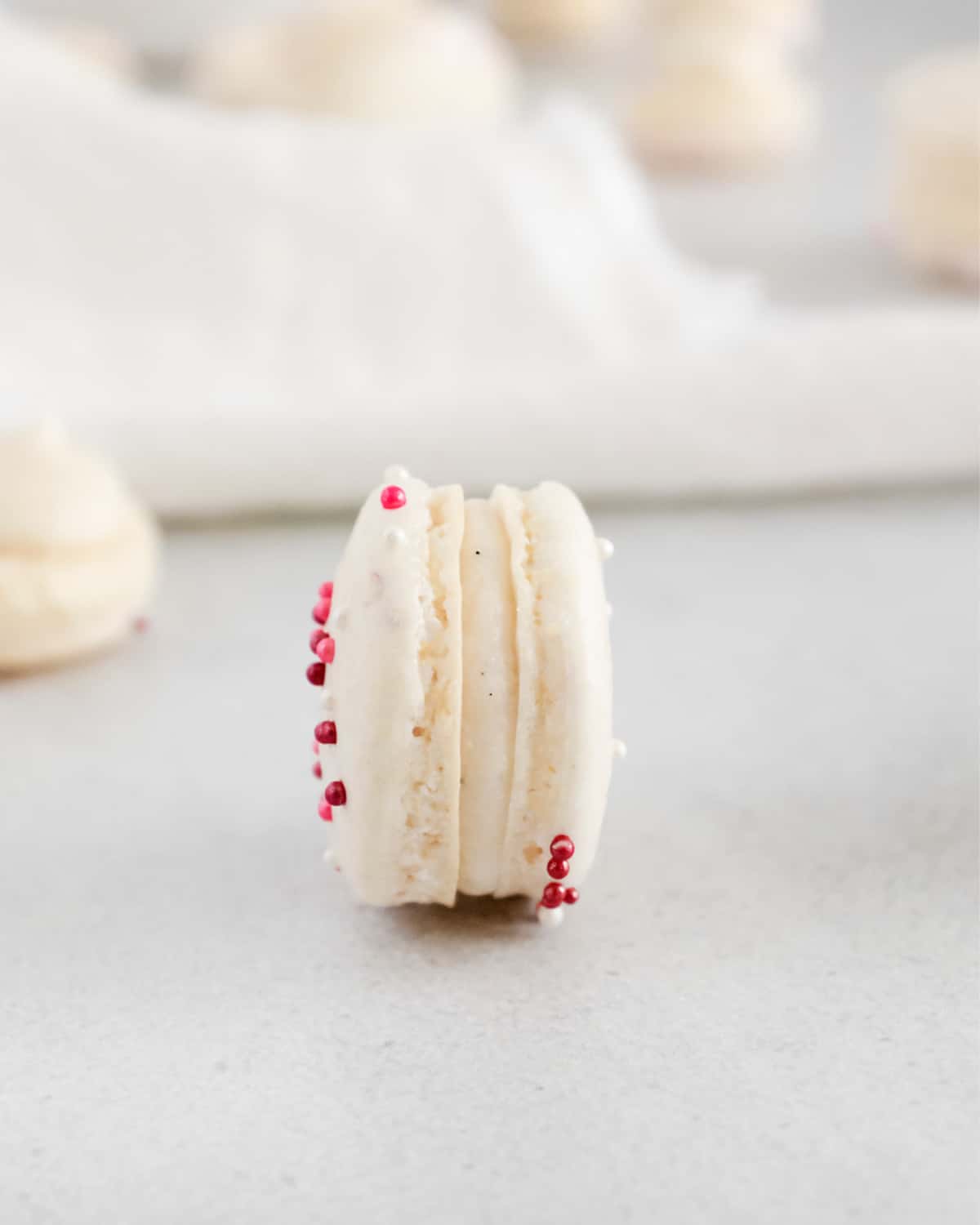
Ingredient Notes
Egg Whites. Your egg whites can, but do not have to be, at room temperature.
White caster sugar is a superfine sugar that incorporates into the egg whites easier than granulated sugar. Macarons can be made with granulated sugar although your chance of success is often more successful with caster sugar.
You can make your own caster sugar by putting your granulated sugar in a blender or food processor and pulse several times until it is fine in texture.
Almond Flour. Make sure you’re using superfine almond flour— it is not the same thing as almond meal. My preferred brand is Besti (you can order online).
Vanilla Bean Powder. If you don’t have vanilla bean powder, you can leave it out. I do not recommend substituting vanilla extract as added liquid can destabilize the meringue.
Tips and Tricks
- For best results, use a kitchen scale to measure the macaron shell ingredients.
- Soft vs. Stiff Peaks: A soft peak leans to the side and curls at the top. A stiff peak stands straight up with the peak pointing upwards.
- If your almond flour seems wet or oily, bake it at 300F for 8-10 minutes to dry it out. You don’t want it to brown— just dry.
- I always recommend using a metal bowl when making macarons as the eggs whites can attach to metal easier than they can to glass. This allows the meringue to stabilize more while also incorporating more air.
- Proper Folding Technique: Move the spatula in a “j” shape by cutting the middle of the meringue and then sweeping the spatula along the bottom of the bowl to one side and then back over the top. Turn the bowl 90 degrees and repeat.
- Proper Oven Temperature: Most home ovens do not have accurate temperature gauges— therefore it’s important to have an oven thermometer so you truly know what temperature your oven is. You want the temperature in your oven to be as close to 315 degrees F as possible.
- Sheet Pans. My number one trick for perfect macarons is to double up your sheet pans! I use USA Pans— good quality aluminum pans— and I double them to insulate the macarons and prevent the bottoms from becoming overheated (which could lead to browning and/or spreading).
- Figure 8. My second trick for perfect macarons is to test the meringue often during the macaronage stage (see step by step instructions). Macaronage is by far one of the most common problems encountered when making macarons because it has to be done perfectly! Doing the figure 8 test often (after every fold) will ensure that you achieve the perfect consistency every time!
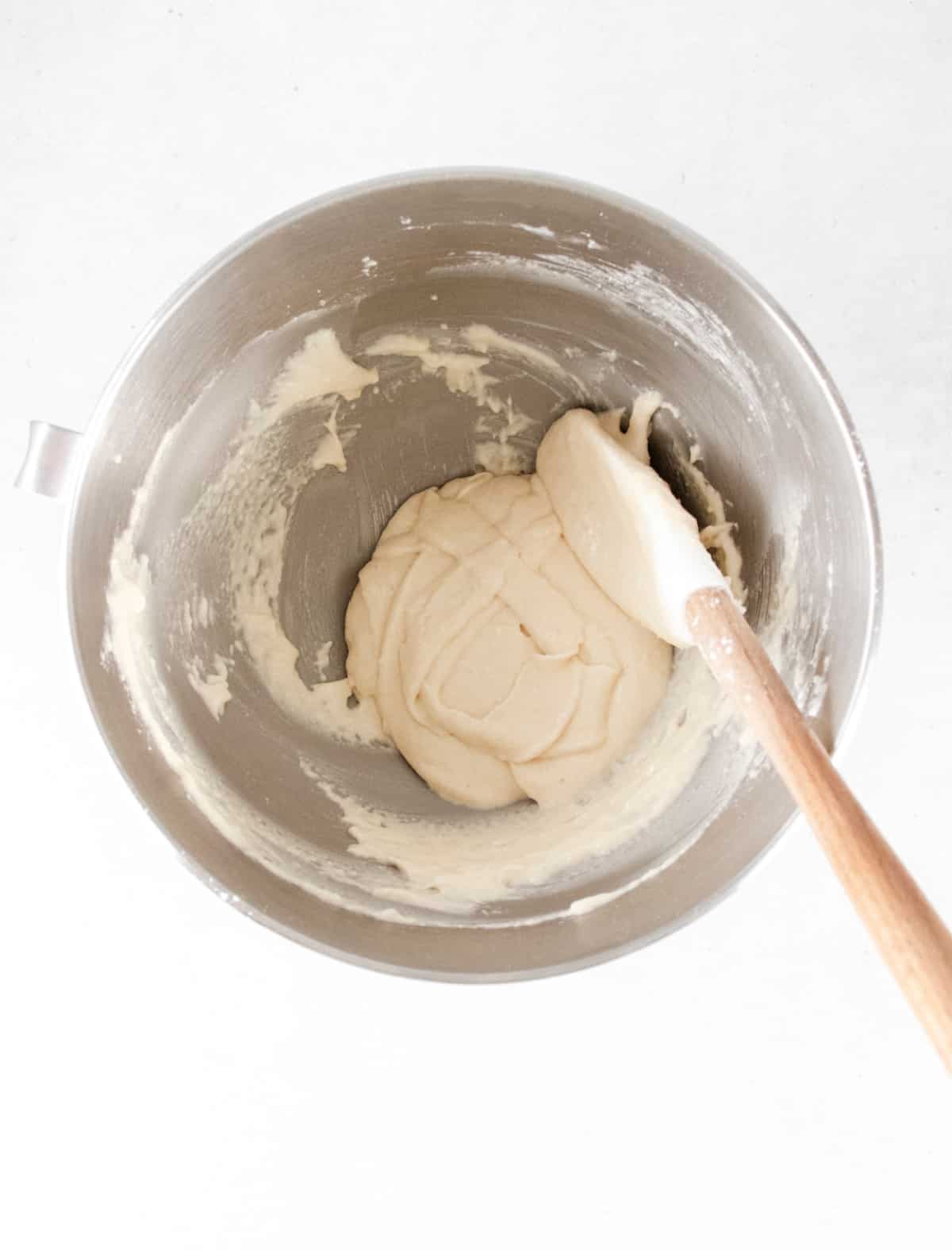
Whipping the Egg Whites
Under Whipped Egg Whites
What to Look For: Your egg whites are under whipped when they don’t hold a stiff peak. Slowly pull the whisk out of the meringue. If the peak in the bowl stands straight up, the meringue is ready. If it tips to one side or bends at the top, continue whipping the egg whites.
The Result: Under whipped egg whites won’t be stable enough to maintain their structure and you’ll end up with a runny meringue and macarons feed that spread outward instead of upward.
Over Whipped Egg Whites
What to Look For: Your egg whites are over whipped when they have multiple stiff peaks. Slowly pull the whisk out of the meringue, if egg whites clump around the whisk and there are multiple stiff peaks, your egg whites are likely over mixed. Unfortunately there is no way to salvage over whipped egg whites.
The Result: Over whipped egg whites have been beaten too far and thus, some of their proteins have been denatured. This will result in macarons that rise upwards but have a hollow shell and weak top crust. The macaron tops will shatter when lightly tapped.
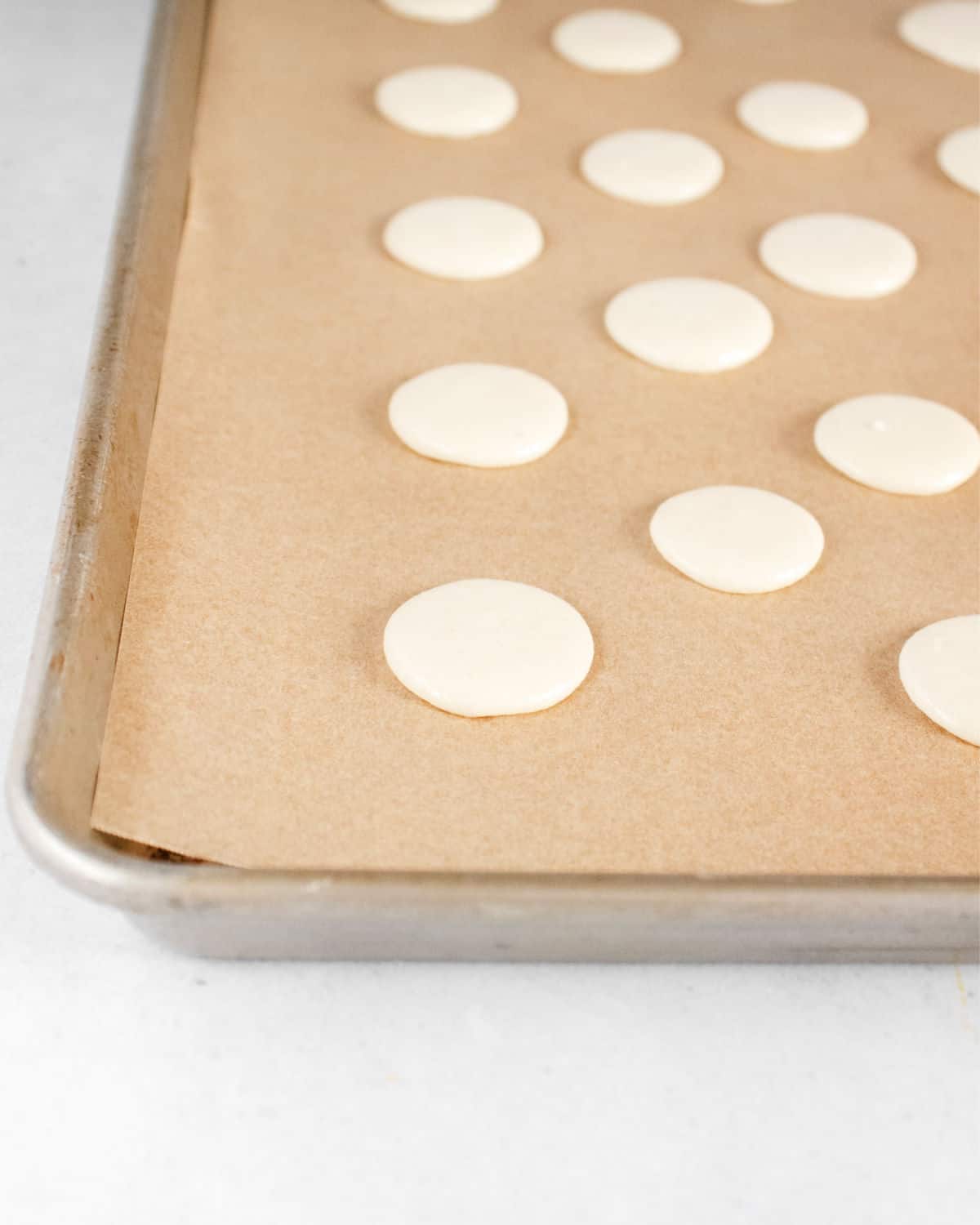
Macaronage
Not Deflating the Meringue Enough
What to Look For: When you perform the figure 8 test, the meringue will fall off the spatula in clumps rather than a steady stream. Continue folding the meringue until the batter flows smoothly during the figure 8 test.
Perfect meringue should have a consistency similar to honey or caramel.
The Result: If you don’t deflate the meringue enough, it will have too much air. This will result in two major problems: first, the macarons will have “nipples” or small points where you’ve piped them. Second, the macarons may crack during baking as the air escapes.
Deflating the Meringue Too Much
What to Look For: The meringue has been deflated too much if it all falls off the spatula at once (rather than in a stream) and spreads out in the bottom of the bowl. If the meringue has a more liquid consistency (like cake or pancake batter), it has likely been over mixed.
The Result: Deflating the meringue too much will cause the macarons to lose their strength and will result in macaron feet that spread outward rather than upward.
Oven Temperature
Temperature Too Low
What to Look For: Use an oven thermometer. If the temperature is below 315F, increase the set temperature in 5 degree intervals until it stabilizes at 315F.
The Result: An oven that is baking too cold will result often result under baked macarons— they’ll have a wet center, fragile top, and stick to the parchment paper.
Temperature Too Hot
What to Look For: Use an oven thermometer. If the temperature is above 315F, decrease the set temperature in 5 degree intervals until it stabilizes at 315F.
The Result: An oven that is baking too hot will cause the macaron feet to spread outward instead of upward. The center of the macaron will spread outwards resulting in both ruffled feet and a hollow center.
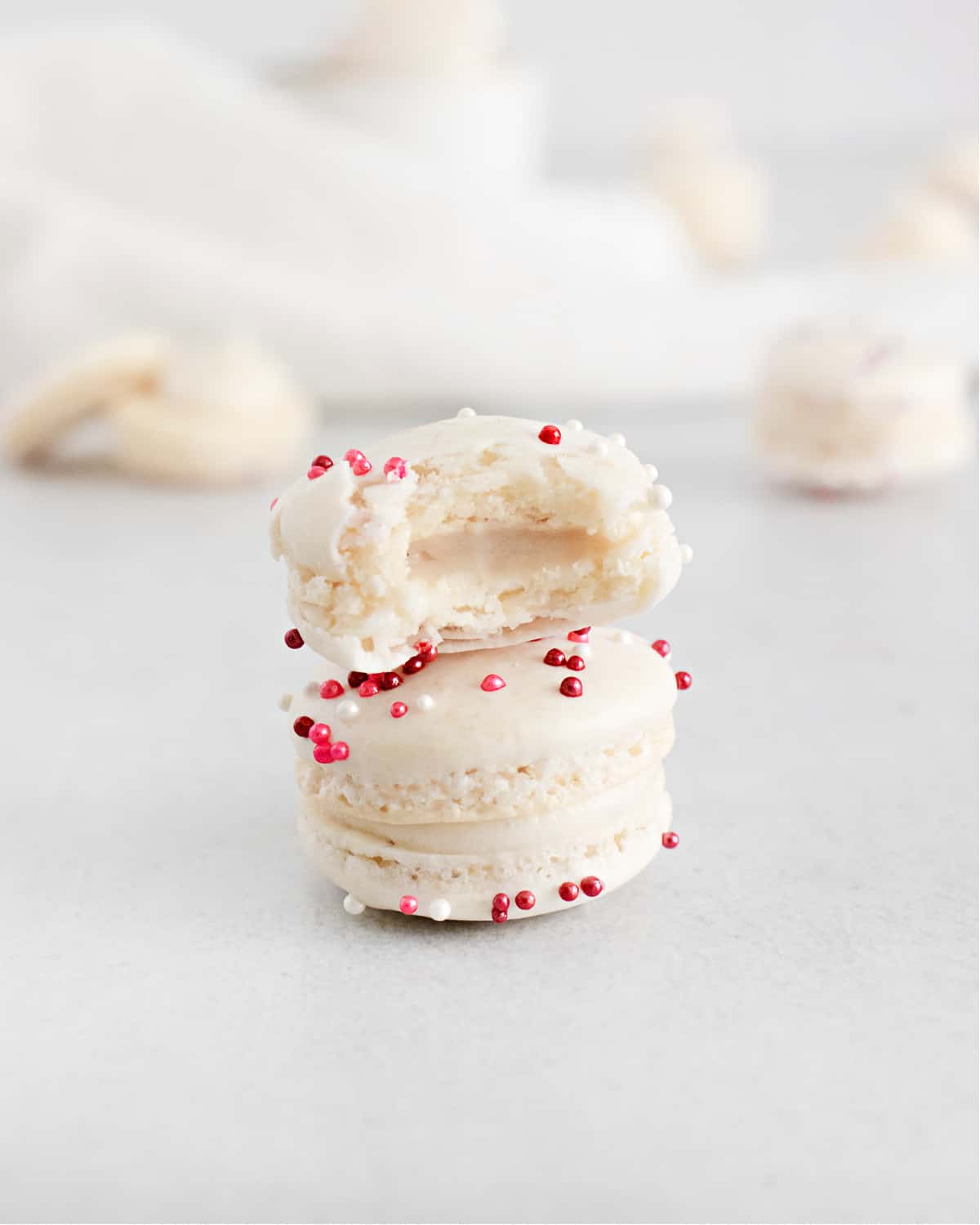
Recipe FAQs
If your macaron tops are cracking, it means there is too much air trapped inside the shell. Try mixing your meringue more during the macaronage stage and drop it a few mores times before resting. Additionally, make sure you are resting the macarons until they develop a skin.
If your macaron feet aren’t even, it could be one of two problems. First, make sure you are holding the piping bag perpendicular to the tray when piping. If you pipe at an angle, one side will be taller than the other and it will result in lopsided feet. If you’re piping correctly, lopsided macarons may be a result of hot spots in your oven. This can be fixed by flipping the macaron try 180 degrees half way through baking.
If your macaron tops cave in when lightly tapped, it means they are hollow and the top has separated from the inside. This could be the result of two things: under baking or over beaten meringue. First, make sure to bake your macarons until they are no longer wet and have fully cooked on the inside. If you’re not sure what to look for, cut
one of the macrons open and see if it is still wet inside. Additionally, when beating your egg whites, make sure to beat them just to a stiff peaks (for additional information on over mixed egg whites, see above).
If your macarons don’t develop feet, it is likely a problem with the rest time. Make sure to rest your macarons just until they develop a skin. Not resting the macarons long enough will result in cracked macarons with small feet while resting the macarons too long will result in macarons without feet (because the sides of the macaron will stick to the parchment and not allow it to rise).
If your macaron feet spread outward rather than upward, it can be the result of two things: over mixing during macaronage or too high of an oven temperature. During macaronage, mix the meringue just until it reaches the figure 8 stage. Additionally, check your oven temperature using an external oven thermometer (see more about oven temperature above).
If the center of your macarons are still wet, they have not been baked
long enough. Continue baking the macarons for another 3-4 minutes and then test their doneness again.
If your macaron tops are browning, cover them lightly with aluminum foil half way through baking.
If your macaron bottoms are browning, try doubling your sheet pans
to insulate the bottom of the macarons—although you may need to add 1-2 minutes to the baking time. If the heat source is at the bottom of your oven, you can also try baking the macarons on a higher rack.
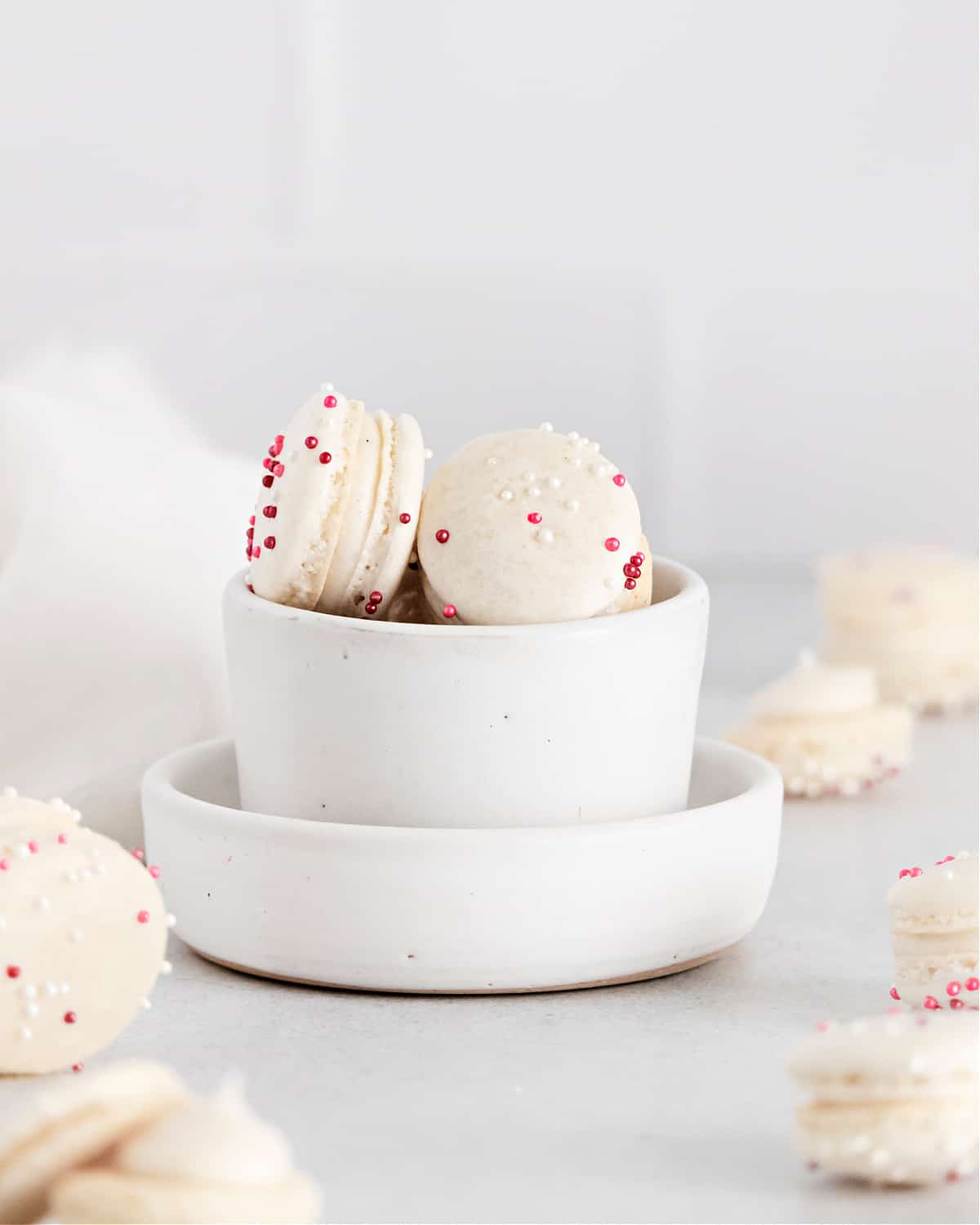
More Macaron Flavors
- Chocolate Macarons with Peanut Butter Filling
- Strawberry Macarons
- Pistachio Macarons
- Lemon Macarons
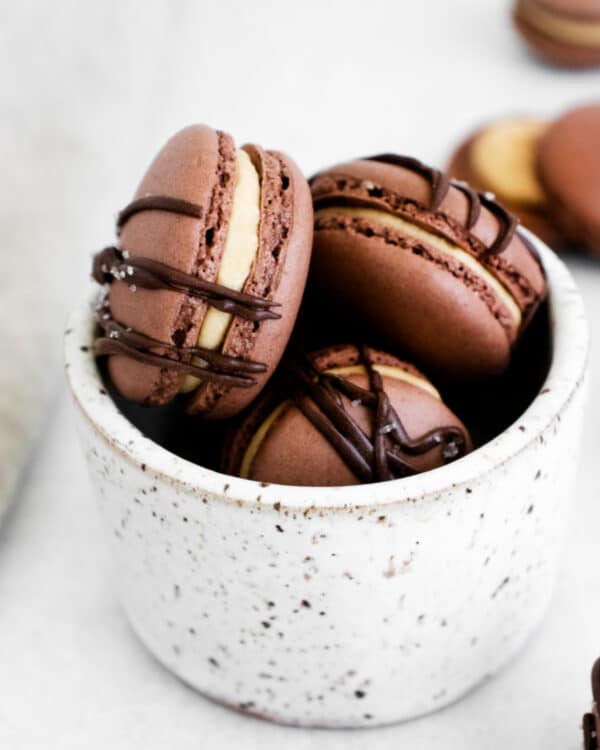

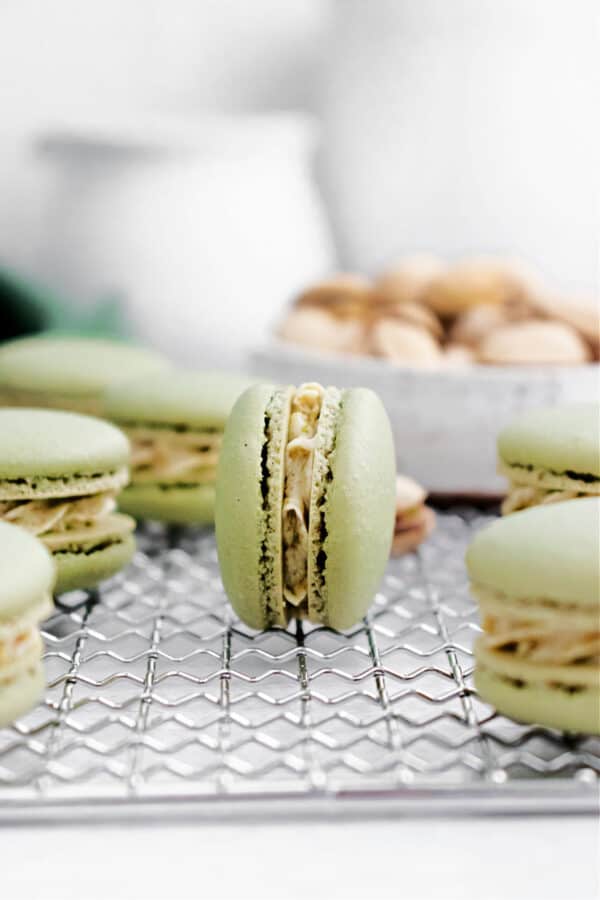
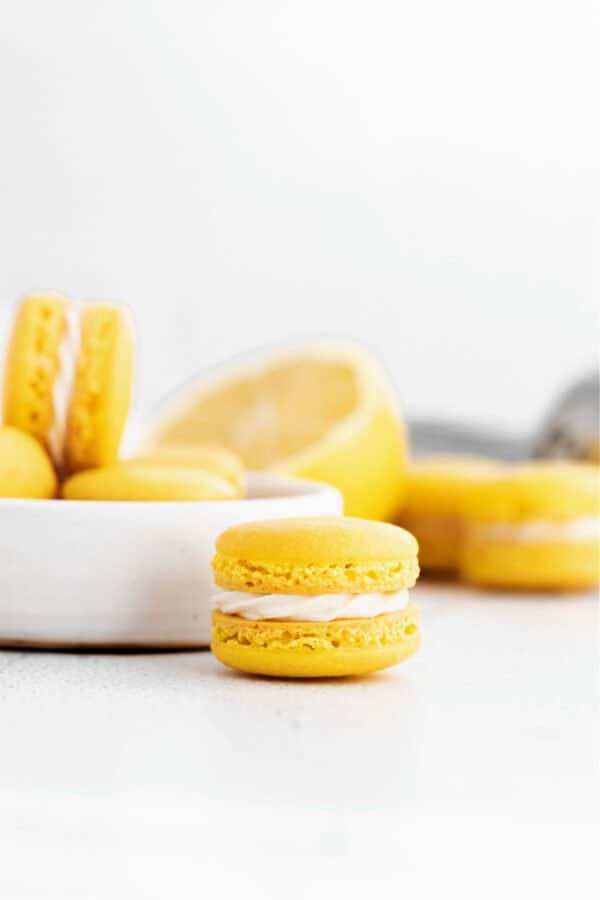
More Cookie Recipes
- Chocolate Macadamia Nut Cookies
- Peanut Butter Chocolate Chip Cookie Bars
- Snickerdoodles
- Chocolate Chip Cookies
- Ricotta Cookies
- Oatmeal Raisin Cookies
Pin this now to find it later
Pin It
How to Make Macarons
Equipment
Ingredients
For the Macaron Shell
- 2 large egg whites 60 grams
- ¼ cup white caster sugar 50 grams**
- 1 ¼ cups powdered sugar 140 grams
- ¾ cup superfine almond flour 80 grams
- ½ teaspoon vanilla bean powder 1 gram**
For the Filling
- 4 tablespoons unsalted butter softened
- 2 tablespoons heavy cream
- 1 teaspoon vanilla bean paste or the caviar from one vanilla bean
- 1 cup powdered sugar
Instructions
For the Macaron Shell
- Line two large sheet pans with parchment paper— make sure the parchment paper lays flat on the pan so your macarons don’t become lopsided.
- Add the egg whites to the bowl of a stand mixer. Using the wire whisk, beat the egg whites on medium speed until they become frothy. With the mixer on medium speed, slowly add in the caster sugar. I like to add about 1 teaspoon of sugar every 2-3 seconds. Adding all of the caster sugar should take about 2 minutes.
- Once you’ve added all of the sugar, turn the mixer to medium-high and beat the egg whites until they form stiff peaks.
- While the egg whites are beating, add the powdered sugar, almond flour, and vanilla bean powder to a fine mesh sieve set over a large bowl. Sift the dry ingredients together— if any large lumps remain in the sifter, discard them— don’t force them
through. - Once the egg whites have reached stiff peaks, add the dry ingredients to the egg whites and gently fold them to combine.
- Once all of the dry ingredients have been incorporated into the egg whites, it’s time for macaronage (deflating the meringue). Smush the meringue against the side of the bowl and then fold it back together. Repeat 2-3 times or until the batter reaches the “lava stage”.
- Once the batter has reached the "lava stage”, you should be able to draw a figure 8 without the meringue stream breaking.
Transfer the batter to a piping bag fitted with a round tip— I use a Wilton #10. - Hold the piping bag straight up and down. Pipe 1” circles that are 1-2” apart on the parchment lined sheet pan.
- Once you’ve filled the tray, hold it approximately 6 inches off the counter and then drop it straight down. Repeat 5 times, or until any large air bubbles have popped. If you’d like to decorate the macarons with sprinkles, add them after you’ve popped any air bubbles— but don’t wait too long as the sprinkles won’t stick if the skin has already formed. Set the macarons aside to rest until they form a skin. This will typically take 20-25 minutes although in humid climates it can take up to an hour. You’ll know the macarons are ready to bake when they are no longer sticky to the touch.
- While the macarons are resting, preheat your oven to 315F. (See notes) Bake the macarons in a preheated oven for 12-15 minutes, or until they are no longer wet in the center.
- Leave the macarons on the pan until they have cooled to room temperature.
For the Filling
- Add the softened butter to the bowl of a stand mixer fitted with the paddle attachment. Beat the butter on high speed until light and airy— about 1 minute.
- Add the heavy cream and vanilla bean paste. Mix on low speed until just combined.
- With the mixer on low, slowly add in the powdered sugar. When all of the powdered sugar has been added, turn the mixer speed to high and whip the icing until it becomes smooth and airy— about 2 minutes.
- Transfer the icing to a piping bag and set it aside.
Assemble & Age
- Place the macarons in similar sized pairs. Pipe a small circle of icing onto the flat side of one macaron. Place the second macaron on top and press down gently to push the icing to the edges. Repeat with the remaining macarons.
- Store the macarons in an airtight container in the refrigerator overnight to age. Store macarons in an airtight container in the refrigerator for up to 3 days. Bring the macarons to room temperature before serving.
Notes
- For best results, use a kitchen scale to measure the macaron shell ingredients.
- Soft vs. Stiff Peaks: A soft peak leans to the side and curls at the top. A stiff peak stands straight up with the peak pointing upwards.
- If your almond flour seems wet or oily, bake it at 300F for 8-10 minutes to dry it out. You don’t want it to brown— just dry.
- I always recommend using a metal bowl when making macarons as the eggs whites can attach to metal easier than they can to glass. This allows the meringue to stabilize more while also incorporating more air.
- Proper Folding Technique: Move the spatula in a “j” shape by cutting the middle of the meringue and then sweeping the spatula along the bottom of the bowl to one side and then back over the top. Turn the bowl 90 degrees and repeat.
- Proper Oven Temperature: Most home ovens do not have accurate temperature gauges— therefore it’s important to have an oven thermometer so you truly know what temperature your oven is. You want the temperature in your oven to be as close to 315 degrees F as possible.
- Sheet Pans. My number one trick for perfect macarons is to double up your sheet pans! I use USA Pans— good quality aluminum pans— and I double them to insulate the macarons and prevent the bottoms from becoming overheated (which could lead to browning and/or spreading).
- Figure 8. My second trick for perfect macarons is to test the meringue often during the macaronage stage (see step by step instructions). Macaronage is by far one of the most common problems encountered when making macarons because it has to be done perfectly! Doing the figure 8 test often (after every fold) will ensure that you achieve the perfect consistency every time!
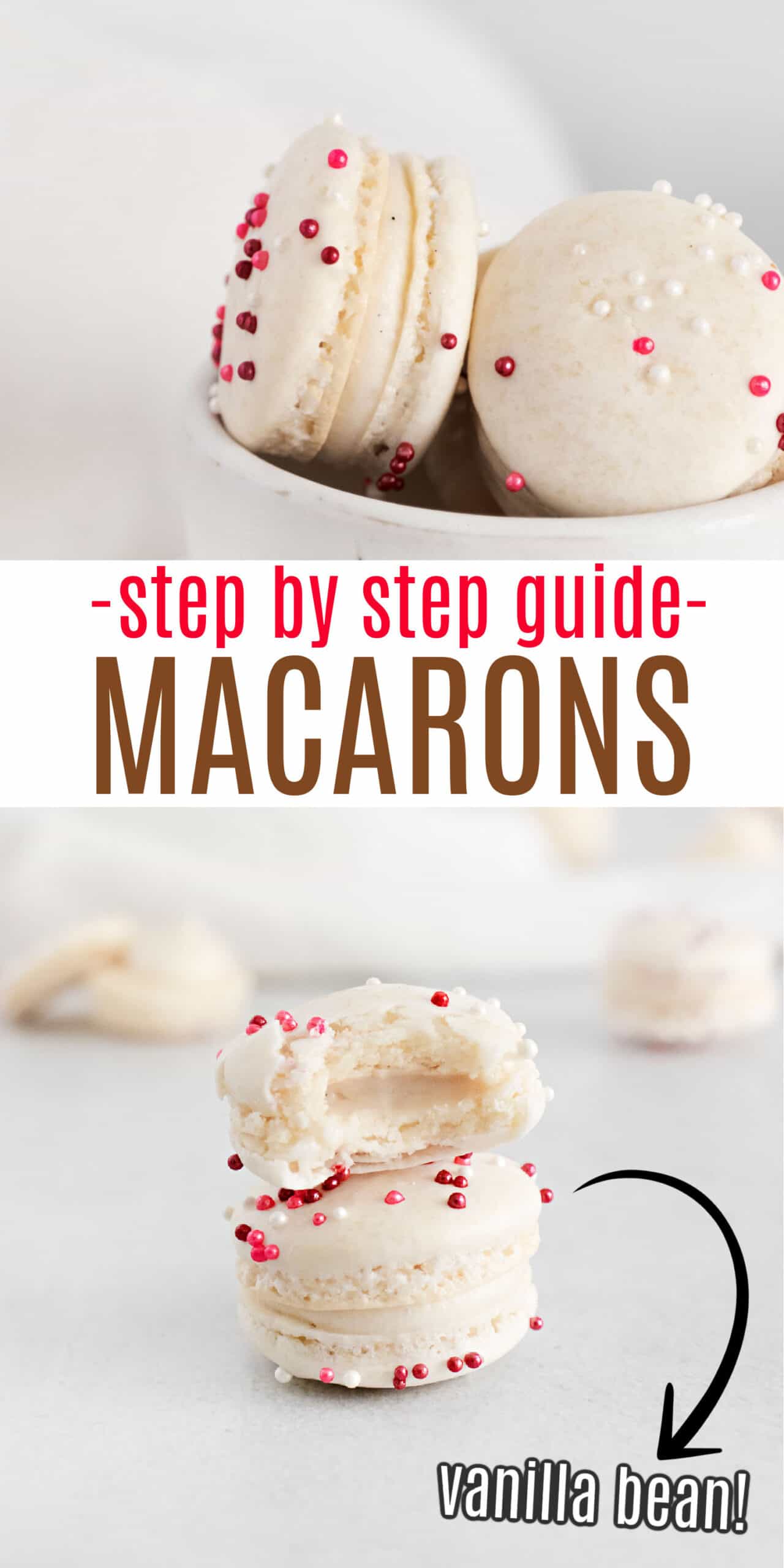
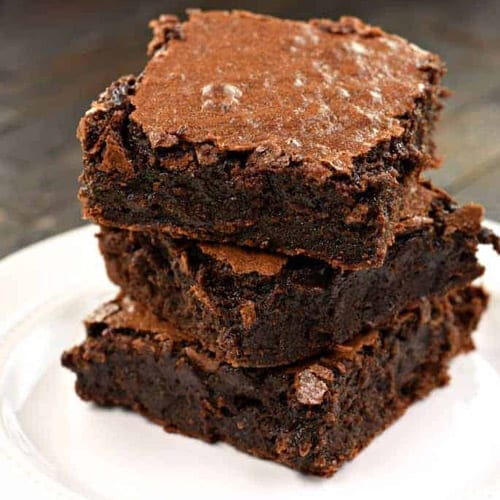
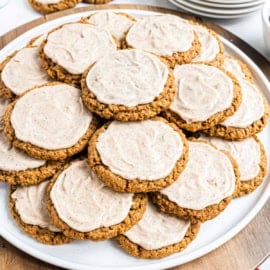
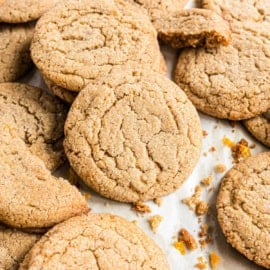

How much castor sugar should be used? In blog post you say use castor , then on recipe card you say powdered sugar. These are not usually interchangeable
?
In the recipe card it says 1/4 cup caster sugar AND 1 1/4 cup powdered sugar. You need both.
Thank you for this awesome recipe and for sharing some tips and tricks too. My first time ever and they came out great! , I think I found a new favorite recipe for macarons!
This quickly disappeared at my house! Everyone loved it!